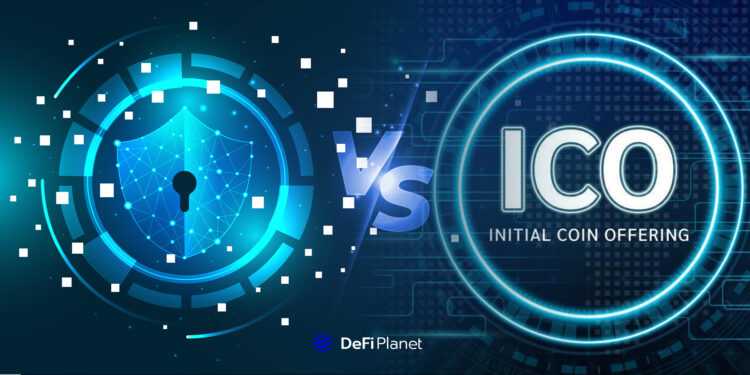Last updated on May 27th, 2025 at 12:57 pm
Imagine being able to invest in the next big tech revolution with just a few clicks. That’s exactly what Initial Coin Offerings (ICOs) promised when they exploded onto the scene.
Startups could raise millions—sometimes even billions—without the red tape of traditional fundraising. The appeal was undeniable: fast, borderless funding for ambitious projects. But as with many gold rushes, chaos followed. Scams ran rampant, projects failed, and investors lost fortunes overnight.
Then came Security Token Offerings (STOs), a more structured, legally compliant alternative that integrated the safeguards of traditional finance while still embracing blockchain innovation.
But which one is truly better? Are ICOs still worth the risk, or have STOs already won the battle for legitimacy? Let’s start with the basics.
What Is an Initial Coin Offering (ICO)?
An ICO is a way for new blockchain-based projects to raise funds by selling digital tokens to investors. Instead of buying shares in a company, investors receive tokens that grant them access to the project’s future services or products. These tokens can often be traded on different platforms, potentially increasing in value over time.
Since ICOs are not bound by strict legal regulations, they are easier and faster to launch, making them a popular choice for startups. However, the lack of oversight has led to fraudulent schemes, making ICOs risky for investors.
What Is a Security Token Offering (STO)?
An STO is a more regulated way for companies to raise money using digital tokens. Unlike ICOs, these tokens represent real financial assets such as company shares, real estate, or investment funds. This means investors get legal rights similar to traditional stockholders, such as earning dividends or having a say in company decisions.
Because STOs follow strict financial regulations and require approval from government authorities, they provide more security and transparency for investors. While the process takes longer and involves more legal steps, it significantly reduces the risk of fraud and investor losses.
How ICOs Lost their Appeal and STOs Took Over
ICOs experienced massive growth between 2016 and 2018, but due to scams and regulatory crackdowns, their popularity has sharply declined. In 2018 alone, over 80% of ICOs turned out to be scams, and by 2019, governments worldwide had imposed strict rules or outright bans, discouraging new ICO projects.
In contrast, STOs are experiencing growing adoption as financial institutions and regulatory bodies embrace security tokens. New trading platforms like tZERO, INX, and OpenFinance have emerged to support security token trading, making STOs more accessible.
Traditional financial players are also entering the STO market. In 2019, Santander Bank issued a $20 million bond as a security token on the Ethereum blockchain, signaling institutional confidence in regulated tokenized securities. Similarly, Switzerland’s SIX Digital Exchange (SDX) is building a fully regulated marketplace for digital securities, further legitimizing STOs as a fundraising model.
With major financial institutions embracing blockchain technology, STOs are poised to bridge the gap between traditional finance and decentralized assets, offering a compliant and secure way to invest in digital securities.
Why STOs Are Considered Safer Than ICOs
One of the biggest criticisms of ICOs is their high susceptibility to fraud and failure. Since ICOs operate without stringent legal oversight, many projects have launched, raised funds, and disappeared without delivering a product.
A prime example is BitConnect, a now-infamous ICO that lured investors with promises of extraordinary returns, only to be exposed as a Ponzi scheme. When the platform collapsed, investors lost over $2 billion. Similarly, Pincoin and iFan, two Vietnamese ICOs, scammed investors out of nearly $660 million before their founders vanished. Another high-profile case is the Centra Tech ICO, which raised $25 million and was endorsed by celebrities before being shut down by regulators for fraudulent activities.
STOs, on the other hand, offer significantly higher security. Since they are legally recognized as securities, they must adhere to strict compliance requirements like periodic audits, transparency in financial reporting, and investor rights protections. For example, tZERO, a blockchain-based security token trading platform, is registered with the SEC and follows all required legal protocols, ensuring that investors receive real asset-backed tokens.
Additionally, STOs enforce KYC/AML verification, ensuring that only vetted investors can participate. This reduces the risk of money laundering, identity fraud, and illicit activities. Because of these legal safeguards, STOs provide investors with more trust and long-term stability compared to ICOs.
Which Model Benefits Startups and Investors More?
ICOs have historically been an easy and fast way for startups to raise capital, with minimal regulatory barriers. Between 2017 and 2018, ICOs raised billions of dollars, with major projects like EOS ($4.1 billion), Telegram ($1.7 billion), and Tezos ($232 million) securing massive funding. However, as regulatory scrutiny increased and scams became more common, ICO success rates declined. In 2020, ICO fundraising dropped significantly, with many investors shifting their focus to more secure investment models.
STOs, while requiring more regulatory approval, offer greater legitimacy and long-term investment potential. Because they provide legally recognized ownership rights, they attract institutional investors and venture capital firms that prefer regulated assets.
For startups, ICOs provide quick and easy fundraising, but they carry a higher risk of failure and legal repercussions. STOs, though slower and more expensive to set up, attract higher-quality investors and provide a stable, compliant financial structure for long-term growth.
How STOs and ICOs Are Treated by Governments
ICOs have historically operated in a legal gray area, with some countries permitting them, others banning them outright, and some imposing regulatory restrictions. Because ICOs do not always fall under traditional securities laws, they often bypass financial regulations. However, this lack of oversight has led to widespread fraud and scams.
For example, in China, ICOs were banned on the 4th of September, 2017 due to concerns over financial instability and fraud. Similarly, South Korea imposed a ban the same year, citing risks of investor exploitation. The U.S. Securities and Exchange Commission (SEC) has taken legal action against multiple ICO projects, such as Telegram’s $1.7 billion ICO, which was halted in 2019 for violating U.S. securities laws. The SEC determined that Telegram’s token, Gram, was an unregistered security, forcing the company to refund more than $1.2 billion to investors and to pay an $18.5 million civil penalty.
In contrast, STOs are treated like traditional securities and are subject to strict regulations. In the United States, STOs must comply with the Securities Act of 1933, requiring issuers to register their offerings with the SEC or qualify for exemptions like Regulation D, Regulation S, or Regulation A. These regulations ensure investor protection through measures like Know Your Customer (KYC) and Anti-Money Laundering (AML) policies.
The European Union (EU) follows a similar approach. STOs must comply with MiFID II (Markets in Financial Instruments Directive) and obtain approval from financial regulators like BaFin in Germany or the Financial Conduct Authority (FCA) in the UK.
Due to these regulations, STOs attract institutional investors and financial institutions, while ICOs primarily appeal to retail investors looking for high-risk, high-reward opportunities.
The Differences Between ICOs and STOs
| Feature | ICO | STO |
| Regulation | Not regulated, making it easier and faster to launch. | Strictly regulated and requires approval from financial authorities. |
| Token Purpose | Provides access to a product or service but does not grant ownership. | Represents real assets, giving investors legal ownership rights. |
| Investor Rights | No stake in the company, no voting rights, or guaranteed financial returns. | Investors may receive dividends, voting rights, or a share of profits. |
| Risk Factor | High risk due to lack of oversight; scams and price manipulation are common. | Lower risk as strict regulations ensure investor protection. |
| Liquidity & Trading | Tokens can be freely traded on most cryptocurrency exchanges. | Can only be traded on specialized, regulated platforms. |
| Compliance Requirements | Few to no legal requirements for investors. | Investors must go through identity verification and approval processes. |
| Speed of Fundraising | Quick and straightforward, making it attractive for startups. | Slower process due to regulatory approval but offers long-term stability. |
Final Thoughts
The rise and fall of ICOs show how innovation can sometimes outpace regulation—bringing both opportunities and risks. While ICOs opened the door for a new era of decentralized fundraising, their lack of oversight led to scams, instability, and a loss of investor confidence.
STOs, on the other hand, have emerged as the more secure and regulated alternative, offering legal protections and attracting serious investors. But they come with trade-offs: a longer setup process, more regulatory hurdles, and higher costs.
So, which model is better? It depends on your perspective. If you’re looking for quick fundraising with high risk and high reward, ICOs might still hold some appeal. But if security, transparency, and long-term stability matter more, STOs are likely the future of blockchain-based fundraising.
Disclaimer: This piece is intended solely for informational purposes and should not be considered trading or investment advice. Nothing herein should be construed as financial, legal, or tax advice. Trading or investing in cryptocurrencies carries a considerable risk of financial loss. Always conduct due diligence.
If you would like to read more articles like this, visit DeFi Planet and follow us on Twitter, LinkedIn, Facebook, Instagram, and CoinMarketCap Community.
Take control of your crypto portfolio with MARKETS PRO, DeFi Planet’s suite of analytics tools.





















